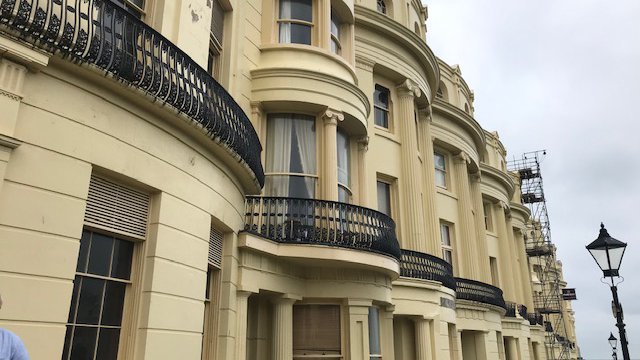

I had a ball at the Regency Townhouse in Brighton. Its a townhouse on the Sussex coast built in the 1820s that's in the process of being restored and made into a heritage center. We first had a tour of the house to learn about techniques used to research restoration efforts. We saw how they did paint testing which involves sanding away circles in a few places in a room to find all the paint layers. If there have been enough paint jobs you get a very 'gob-stopper' looking spot on the wall. They did this testing in the Dining Room which was a lovely mauve color. They did quite a few test spots around the room to make sure they layers matched up. If the first few colors were missing in one of the test spots it could tell you if the wall was built later.
The next day we got to do some hands-on plaster work for walls and molding. We learned a ridiculous amount of stuff about plaster:
-Plasterers can make their mixture months in advance and let it sit in water.
-Adding volcanic ash (pozzolanic ash) can cure lime in a molecular reaction to make a less porous material. It can cure underwater! The Romans fully developed this method for underwater building.
-Lyme blasted plaster is recyclable- if its damages you can just crush it up, add wet, and re-plaster the area using all original materials.
-To make a good mortar you wash your sand (aggregates) first to wash away the fine parties so the weather can't do it once the building
is done.
-Gelatin molds for plaster work in Georgian times were cheap and easy to make because there were loads of dead beast bones to use.
-Setting plaster creates heat and can burn you! Plaster burns were and still are a risky part of plaster work.
For the practical part of the lesson we mixed a gritty plaster in a bathtub for the scratch coat on the walls. We sprinkled in yak hair, because it has a large tubial, very strong, to make the mixture stay together. We practiced using a hawk and trowel to coat a free-standing lath wall with plaster then went inside to patch up exposed lath in a staircase. I think I had a pretty good hand at it.
At the townhouse the Open Palace Program members also got to make individual meat pies in the historic basement kitchen, then eat those meat-pies at a nice dinner in a half-way remodeled room on the second floor. As a history buff I thought it was a fantastic setting for dinner.

Museum Professional. Traveler. Cat lover.